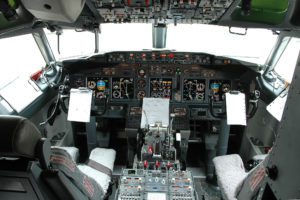
Photo: 123RF
A Boeing 737 Cockpit
Is it possible for someone who has never flown before to successfully land an airliner?
For that someone who has never flown, the chances of successfully bringing the plane down safely are almost nil.
But, if that passenger is a general aviation enthusiast, a computer geek on the Microsoft Flight Simulator or at least a pilot on vacation or on duty, the chances are better.
Equally, if the plane is a light aircraft, there is some hope too. In August 7, 2000, the pilot of a single engine plane collapsed over the controls. A passenger took over the plane and landed it safely after he was talked down by an airborne flight instructor.
A light aircraft is more forgiving than an airliner. The rule to fly is very simple. Pitch (push or pull on the flight controls) for speeds, and power for altitude. If your speed is dropping you push the nose down and vice versa if speed is increasing. If you are too low, you add power and the aircraft will gain altitude. These instructions can be easily given by someone qualified in the air.
Airliners with jet engines are extremely powerful and speed control is incredibly difficult to a non-pilot. They have so much inertia that a simple pitch trick would not get you the required speed. As such, if you pitch down you will lose altitude and likely crash if you are close to the ground
On a small plane you can correct the center line easily. As it is light and nimble you can align it late and still get the job done.
In an airliner, you need to get it stabilized a long way from the runway. As they are heavy and due to inertia, you cannot really correct a messed-up approach close to the ground. So, you need careful power adjustment to get the right speed, something a layman lacks.
On the other hand, if that passenger is another pilot, preferably trained on that type of aircraft, that would be the best solution. Second best would be a novice pilot or flight simulator enthusiast that is able to follow radio instructions to program the flight management computer.
The key to a successful landing is using the aircraft autopilot and get the aircraft stabilized on a long final approach on a Category III ILS (Instrument Landing System) for a successful auto-landing.
After touch down the passenger would have to retard the thrust levers and disconnect the autopilot. Most aircraft have auto brakes, so he only has to apply the toe brakes below 60 knots.
The passenger just has to monitor the plane deceleration and be ready to brake if autobrake is not functioning after the landing.
A non-pilot wouldn’t have the slightest idea how to even work the communications radios of a commercial airliner, let alone fly and land the plane safely.
On records, no passenger has ever landed an airliner, but that’s mostly because no one has ever had to try it.
However, it has happened mainly on a few light general aviation aircraft, see videos below.
See a YouTube video ‘Passenger Lands a Plane after Pilot Becomes Incapacitated’ below
See a YouTube video on PASSENGER LANDS PLANE After Pilot Incapacitation here
https://www.youtube.com/watch?v=9Jy8jpfyiek
See a YouTube video on ‘How YOU can land a passenger aircraft!’ here
https://www.youtube.com/watch?v=ePDl1JNqjpM